#tsukigata
Text

It takes two to symbolically patricide...
#tsukigata#tsukio#artfromthefrogs#golden kamuy#golden kamuy fanart#gk ogata#gk tsukishima#gk tsurumi#tsukishima hajime#lieutenant tsurumi#tsurumi tokushirou#ogata hyakunosuke#gk#oh symbolic patricide how you compell me#thinking of ogata-tsukishima parallels makes me absolute hog wild feral. thinking of them killing tsurumi together makes me even worse.#fuck it im posting it now! space my posts out? i dont even know her!
129 notes
·
View notes
Text

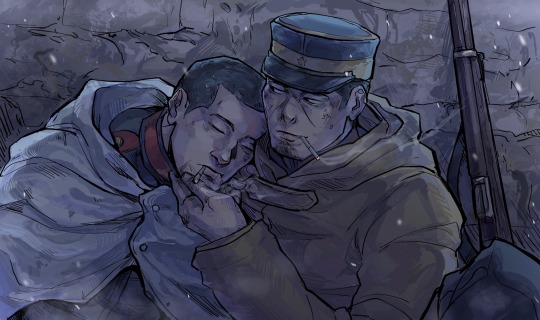
Some TsukiO commissions I’ve done recently, one sweet one spicy >:]
#gay people real. praise be.#golden kamuy#ogata hyakunosuke#tsukishima hajime#tsukigata#otsuki#tsukio#marbleart
151 notes
·
View notes
Text
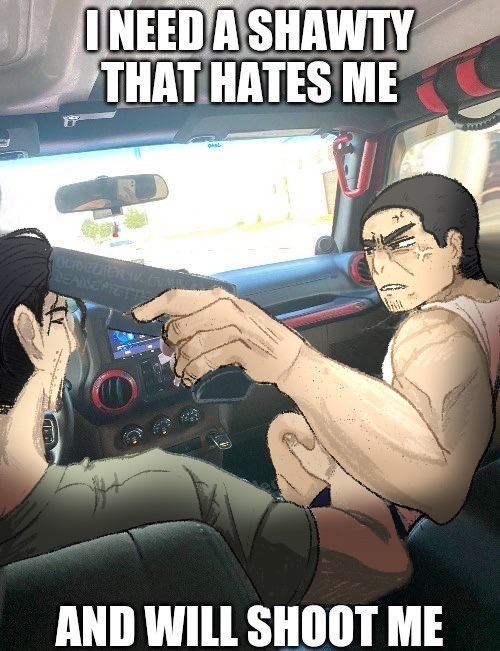
tsukigata nation….. how are we doing this evening?
#golden kamuy#golden kamui#ogata hyakunosuke#tsukishima hajime#ogatsuki#tsukigata#art post#SORRY ABOUT THIS IM ILL. TSUKIKOI ENDGAME THO.
13 notes
·
View notes
Text
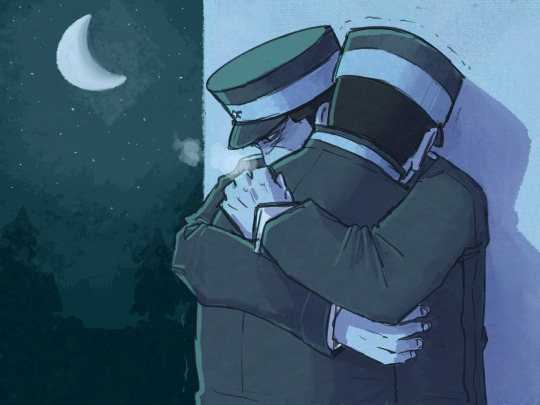
pre-series beginning tsukigata = suffering... ✨together✨
16 notes
·
View notes
Text
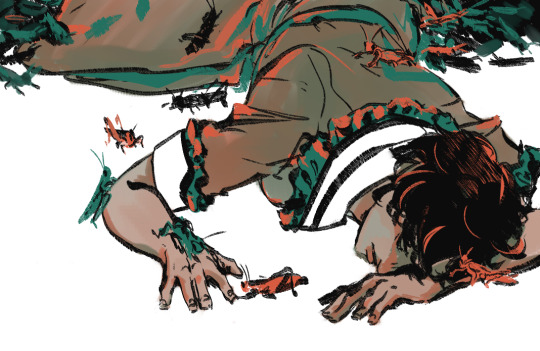
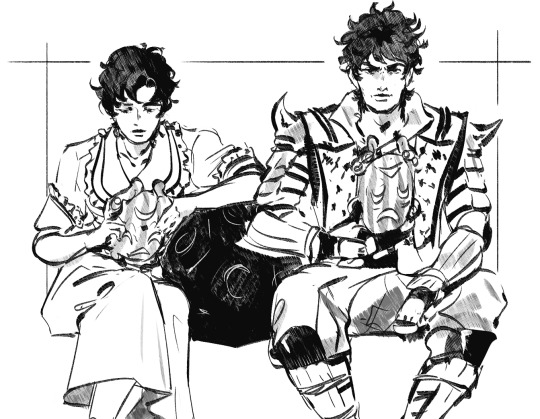
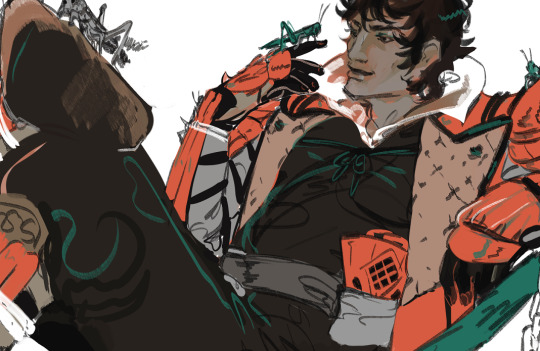
Tsukigata siblings
194 notes
·
View notes
Text
⚠️Vote for whomever YOU DO NOT KNOW⚠️‼️

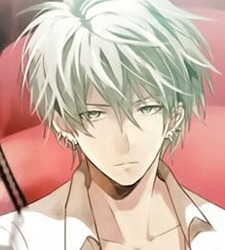
#ultimate obscure blorbo#polls#Round 2#Dahn Tsukigata (Devil Summoner Raidou Kuzunoha)#Daiya Oomine (The Empty Box and the Zeroth Maria)
39 notes
·
View notes
Text
it keeps happening
#gouto and narumi keep going you should find yourself a nice girl raidou#and everyone else is like who is your boyfriend. is this this guy? oh i bet its this guy. no wait it can’t be-#enough about raidous boyfriend!! we have to find the tsukigatas#king abaddon liveblog
10 notes
·
View notes
Text

Films Watched in 2023:
120. 姿三四郎/Sanshiro Sugata (1943) - Dir. Akira Kurosawa
#姿三四郎#Sanshiro Sugata#Akira Kurosawa#Denjirō Ōkōchi#Susumu Fujita#Yukiko Todoroki#Ryūnosuke Tsukigata#Takashi Shimura#Ranko Hanai#Films Watched in 2023#My Post
2 notes
·
View notes
Photo
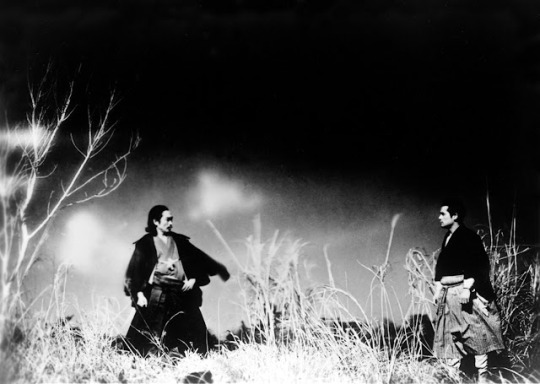
Ryunosuke Tsukigata and Susumu Fujita in Sanshiro Sugata (Akira Kurosawa, 1943)
Cast: Susumu Fujita, Denjiro Okochi, Yukiko Todoroki, Ryunosuke Tsukigata, Takashi Shimura, Ranko Hanai, Sugisaki Aoyama, Ichiro Sugai, Yoshio Kusugi, Kokuten Kodo. Screenplay: Akira Kurosawa, based on a novel by Tsuneo Tomita. Cinematography: Akira Mimura. Art direction: Masao Tozuka. Film editing: Toshio Goto, Akira Kurosawa. Music: Seiichi Suzuki.
You know the plot: A talented, cocky young newcomer takes on the old pros and gets his ass kicked, but he learns self-discipline and becomes a winner. You've seen it played out with young doctors, lawyers, musicians -- it's even the plot of Wagner's Die Meistersinger -- and others challenging the established traditions. But mostly it's the plot for what seems to be about half of the sports movies ever made, including Akira Kurosawa's first feature, Sanshiro Sugata. It's also a film about the conflict between rival martial arts disciplines, jujitsu and judo, but fortunately you don't need to know much about the nature of the conflict to follow the film. From what I gather from reading the Wikipedia entry on judo, the founder of that discipline, Jigoro Kano, wanted to give jujitsu a philosophical underpinning that would put an emphasis on self-improvement for the betterment of society, and he called it judo because "do," like the Chinese "tao," means road or path. Kano's renaming was meant to shift the emphasis from physical skill to spiritual purpose. In Kurosawa's film, young Sanshiro (Susumu Fujita) comes to town wanting to find someone to teach him jujitsu, and signs up with a teacher who accepts a challenge from the judo master Shogoro Yano (Denjiro Okochi) -- the name is an obvious twist on "Jigoro Kano." Sanshiro watches as not only the teacher but all of the other members of his dojo are defeated -- in fact, tossed into the river -- by Yano. Whereupon Sanshiro becomes a follower of Yano's, but has to undergo some defeats and a cold night spent in a muddy pond before he gets the idea of what judo is all about. The film was not a big hit with the wartime Japanese censors, who wanted more aggression and less philosophy in their movies, so 17 minutes were cut from it, never to be seen again. In the currently available print, the missing material is summarized on title cards, but what's left is more than enough to show that Kurosawa arrived on the scene as a full-blown master director. His camera direction is superb, and he knows how to tell a story visually. For example, when Sanshiro joins up with Yano, he kicks off his geta, his wooden clogs, so he can pull Yano's rickshaw more efficiently. Kurosawa cuts to a passage-of-time montage in which we see one of the abandoned geta lying in the road, then in a mud puddle, covered with snow, then tossed aside as spring comes. The film's crucial scene is a showdown between Sanshiro and his jujitsu rival, Higaki (Ryunosuke Tsukigata), in a field of tall grasses, swept by wind with rushing clouds overhead; it's a spectacular effect, even if the battle turns out to be a bit anticlimactic. However much the censors may have disliked it, audiences were enthusiastic enough that Kurosawa was persuaded to make a sequel.
Sanshiro Sugata, Part Two (Akira Kurosawa, 1945)
Cast: Susumu Fujita, Denjiro Okochi, Ryunosuke Tsukigata, Akitake Kono, Yukiko Todoroki, Soji Kiyokawa, Masayuki Mori, Kokuten Kodo, Osman Yusuf, Roy James. Screenplay: Akira Kurosawa, based on a novel by Tsuneo Tomita. Cinematography: Takeo Ito. Production design: Kazuo Kubo. Film editing: Akira Kurosawa. Music: Seiichi Suzuki.
Patched together from what aging film stock could be gathered during the end-of-war shortages in Japan, and interrupted during its filming by bombing raids, Sanshiro Sugata, Part Two was a labor imposed on the writer-director by the studio, Toho, and Kurosawa's lack of enthusiasm for the project shows. The story is routine: Sanshiro has helped judo triumph over jujitsu as the primary Japanese martial art, but he has gone into retreat for several years, honing his spirituality. But one day he comes across an American sailor (Osman Yusuf) beating up a rickshaw driver -- a job he once took on himself -- and thrashes the bully. This brings him to the attention of a promoter who wants to stage a fight between the judo master and an American boxer named William Lister (Roy James). Eventually, after another fighter is beaten to a pulp by Lister, Sanshiro gives in and thrashes Lister, giving the prize money to the fighter who had been beaten. Meanwhile, his old opponent, Gennosuke Higaki (Ryunosuke Tsukigata), whom he defeated at the end of the first film, warns him that his brothers, Tesshin (also Tsukigata) and Genzaburo Higaki (Akitake Kono), are out to revenge themselves for Gennosuke's defeat. They are masters of karate, which originated on Okinawa and was just making its way into mainland Japan at the time when the film is set, the late 19th century. Gennosuke gives Sanshiro a scroll depicting the basics of karate to help him in the eventual fight with the brothers. Naturally, the film concludes with a fight between Sanshiro and Tesshin -- the other brother is recovering from an epileptic seizure -- that takes place in the snow, an echo of the fight in the original film with Gennosuke in a windswept field of tall grasses. This battle is the only part of the film that shows much commitment on the part of Kurosawa, who insisted that the principals fight barefoot in the snow, not without many complaints from the actors. Unfortunately, the poor film stock, unable to provide shades of gray, turns much of this fight into a battle of silhouetted figures. Much has been made of the propaganda in the film, particularly the portrayal of the hapless American sailor and boxer, but Kurosawa, no lover of the imperial regime, manages to shift the film's emphasis to the fearsomely wild Higaki brothers.
3 notes
·
View notes
Text
So the fic I intended to write last night boils down to death wish masochism
Including but not limited to gunplay
And I'm wracking my brain trying to figure out how modern Tsukishima while fucking Ogata would just randomly decide to say "I could kill you, you know?" While balls fucking deep
I need the lead up
The only thought I had was they watched Se7en and that big ass knife strap on got Ogata feeling some sort of way but like?? That's not the easiest to write in a comprehensive way for people who haven't seen the movie to understand???
And Tsukishima needs to bring it up while already going at it
Maybe it was a slow build up? Ogata had started asking for more and more pain play sort of things and this time Tsukishima just eases into it a bit farther than normal?
Urrghhh I don't know
I'd hoped to write it over night and then napped instead because it was all coming up blank..
#im sorry but i love Se7en#I'm heavily projecting onto Ogata like every other Tsukigata i write#it's another trans Ogata too#i have the sex scene down. at least the second half#i just need the lead-up
1 note
·
View note
Text

I think Akane and Katsuya might have more in common then wanting to be pastry chefs.
Their both more on the lawful side, and willing to make personal sacrifices in order to try to do what is best for their family.
Akane is willing to give up her future and dreams of being a pastry chef, in order to secure the villages future.
Katsuya gives up his dream of becoming a pastry chef in order to become a policeman to find the truth behind his fathers demotion, and provide care and university funding for his brother, who does not appreciate him becoming more akin to his parent.
Their siblings contrast. Dahn has his heart in the right place, as in his extremist actions he tries to find a way to give her a future where she and other villagers can have a future without them. He does it by taking luck from the rest of the world. The world is saved. There is a cost. There always is
In contrast, Tatsuya wants distance from his brother. He embarks on a personal quest that leads to him trying to save the world. The world ends in spite of his efforts. Then he gets up and tries again. Its only when he accepts working with other people again, including his brother (from this side) that he manages to save the world, at a cost.
#raidou kuzunoha#Dahn Tsukigata#Akane Tsukigata#raidou kuzunoha vs king abaddon#k watches#katsuya suou#tatsuya suou
1 note
·
View note
Photo

a commission for a fellow tsukigata enjoyer... really loved doodling my babygirls who love each other very much and have done nothing wrong ever.
#artfromthefrogs#golden kamuy#golden kamuy fanart#ゴールデンカムイ#tsukigata#tsukio#tsukishima hajime#golden kamuy tsukishima#tsukishima hajime fanart#ogata hyakunosuke#golden kamuy ogata#ogata hyakunosuke fanart#tsukio fanart#blood tw#babygirl tag
42 notes
·
View notes
Text
The Kamishikimi Kumanoimasu Shrine
Today's post won't be on Len'en, like at all, so uhh, nothing for you if you only care about that I suppose~.
Anyways, I went on a family trip to northern Kyushu around a month ago, so I thought to share some of the neat places I've been to! (Not in any particular order though, just whatever I feel like.)
It'll probably just be the shrines and temples and such, since that's what I'm most interested in, but I'd be more than glad to share the rest of my trip if you all would like to see~!
With that preamble out of the way, here's my visit to the Kamishikimi Kumanoimasu Shrine.
Below: An image of the shrine road going up the mountain, from the official Takamori Town website.
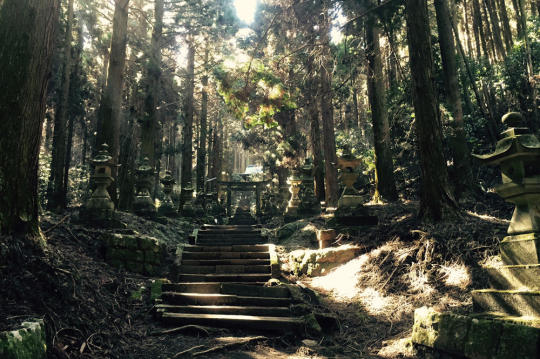
My Visit to the Shrine
Unlike most places on our trip, this is actually a place I've been before, on my last trip around winter 4 years ago. It was just such a wonderful place that we had to bring my little brothers to as well.
(Though they didn't appreciate it much, on account of how incredibly hot it was. Honestly I don't even blame them, it was around 38°C every single day during the trip, so outdoor activity was, tough, to say the least.)
The Kamishikimi Kumanoimasu Shrine (上色見熊野座神社) is Located in Takamori Town, Aso District, Kumamoto Prefecture, on the foot of Mount Tsukigata (月形山), in a place known as Kami-shikimi (上色見 lit. "upper Shikimi", in contrast with Shikimi, located to the east.)
It's accessed directly from the side of a car road, opposite a post office, so we parked our rental car nearby and started heading up the shrine road: A rather long set of stairs up the mountain.
(As another aside, the pictures here were taken by me during the visit, unless otherwise noted, so you'll have to pardon the quality.)
Below: The entrance of the shrine, marked by a sign with the shrine's name beside it. (I had to take this one from the post office parking lot, on account of the traffic lol.)

The road was very tranquil, barring the occasional tourist/visitor, lined with many stone lanterns and trees with the occasional stone torii gate as well.
Below: A few photos that I took along the stairs.

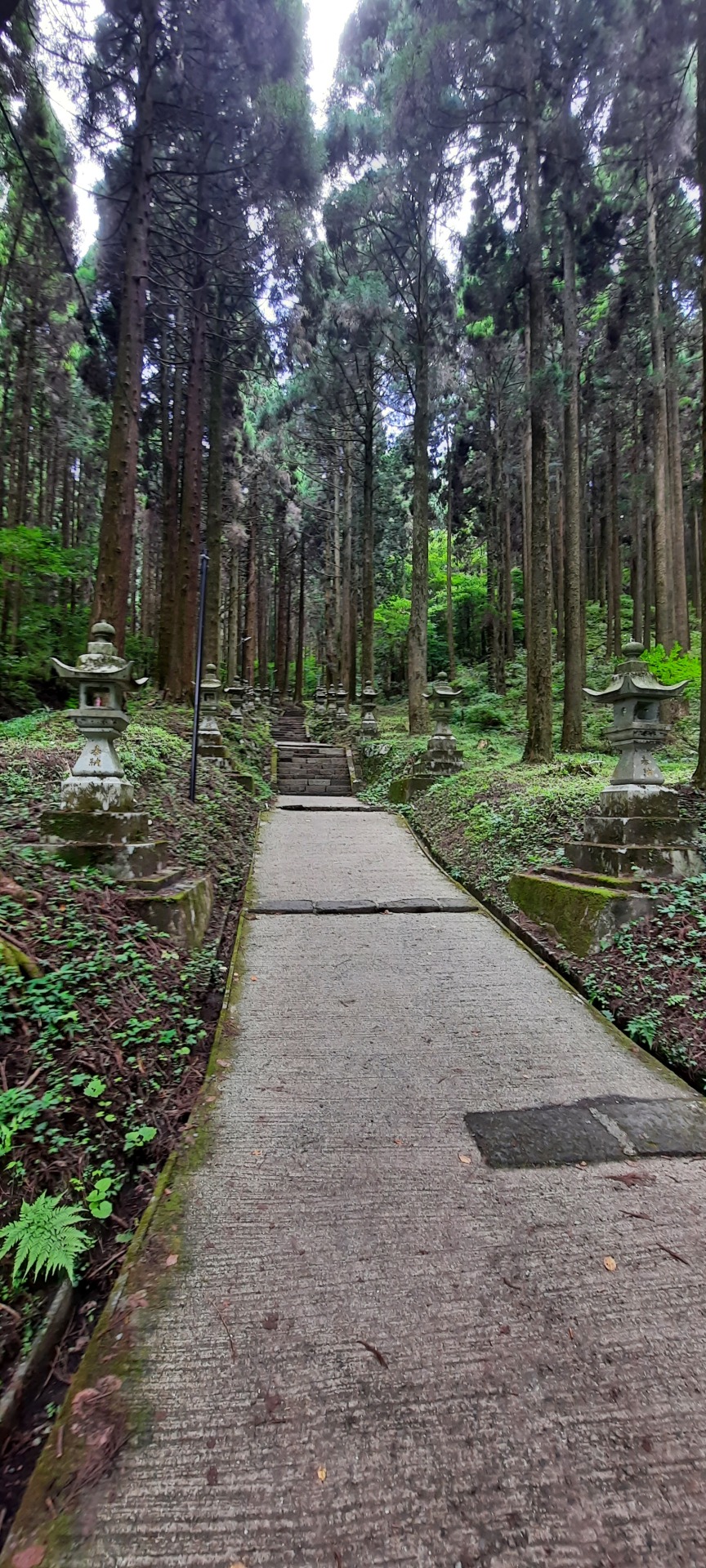


Upon the gates hang a shimenawa rope, noting the sacred space we're entering, alongside the torii itself of course.
Written on the torii's shingaku (神額 lit. "god/divine frame"), the picture-frame like object on the middle of the gate, are the words Kumano-guu (熊野宮 lit. "palace/shrine of Kumano"), an older, alternate name of the shrine.

Along the hike, we came across this stone, clearly divine in nature somehow, considering the money offerings, its being bound by shimenawa and having an oonusa, a type of ritual wand, next to it.
It's quite peculiar, but we'll circle back to it later.
Below: The curious stone.
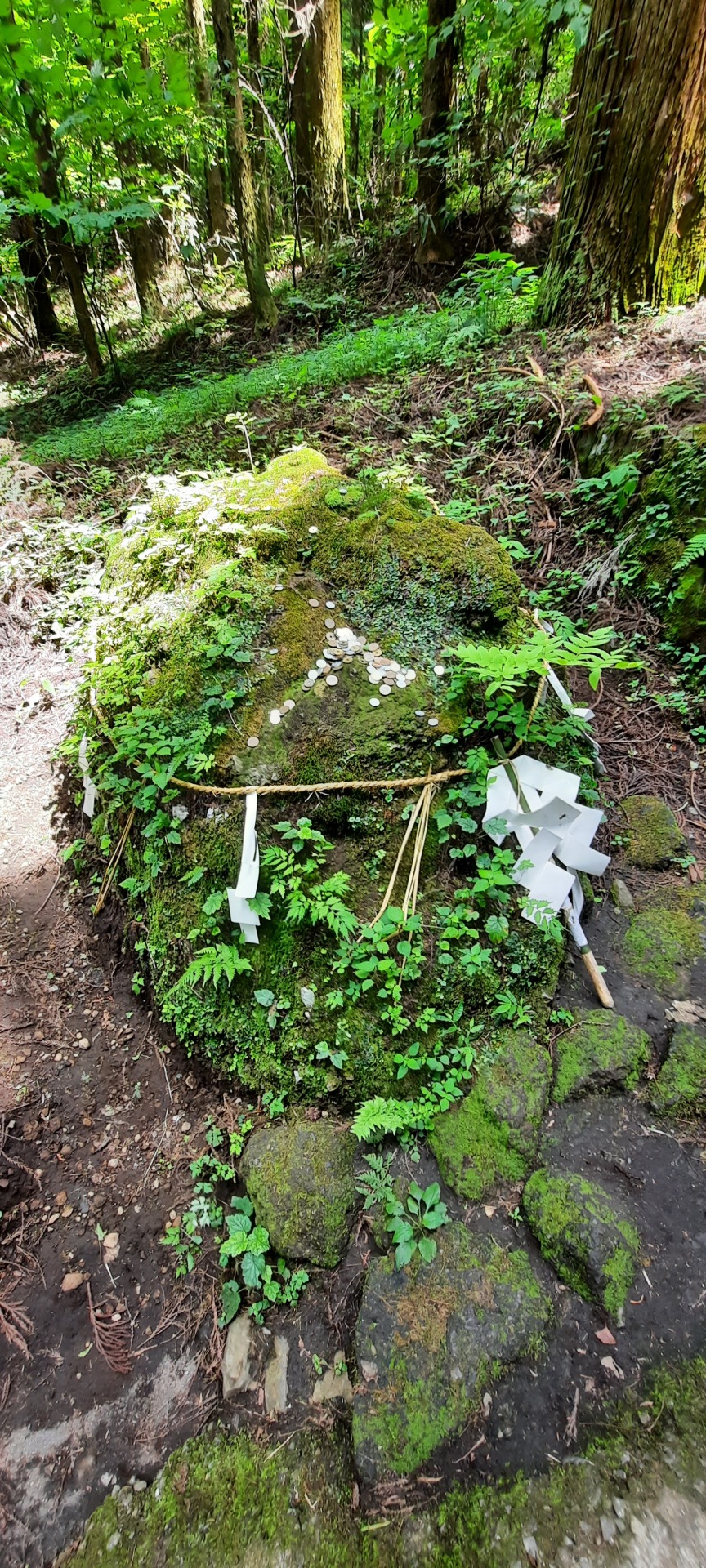
At the end of the stairs, we come face to face with the shrine itself, specifically its prayer hall.
Below: The prayer hall. (It's a bit blurry cause I think I was a bit shaky after climbing all those stairs lol.)

This is where visitors would give their offerings and prayers to the gods, as well as where priests and shrine maidens would've carried out their rituals and performances. (There weren't any during our visit though, this isn't a shrine that's manned every day.)
Below: A view of the entire shrine, from this shrine/temple-focused travel website.
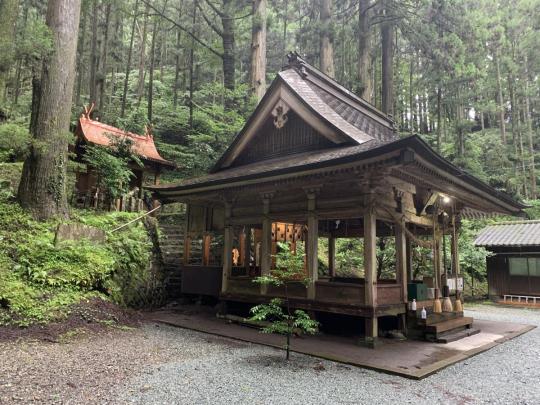
As you can see from the picture here, behind the prayer hall are a set of stairs leading to a smaller building, this is the shrine's main hall, where its shintai, a sacred vessel for the gods' spirits, is housed.
Below: A side view of the main hall.

One would normally assume that this is where the shrine ends, but there's actually a site further up the mountain that's also related to the shrine!
It does demand that we take yet another hike up, but thankfully it's not nearly as long this time (though much more overgrown with grass, as this path is not paved like the shrine road is).
As we hike up, we see our goal, a giant blowing cave known as Ugeto-iwa (穿戸岩).
Below: The path up to Ugeto-iwa as well as the hole itself.
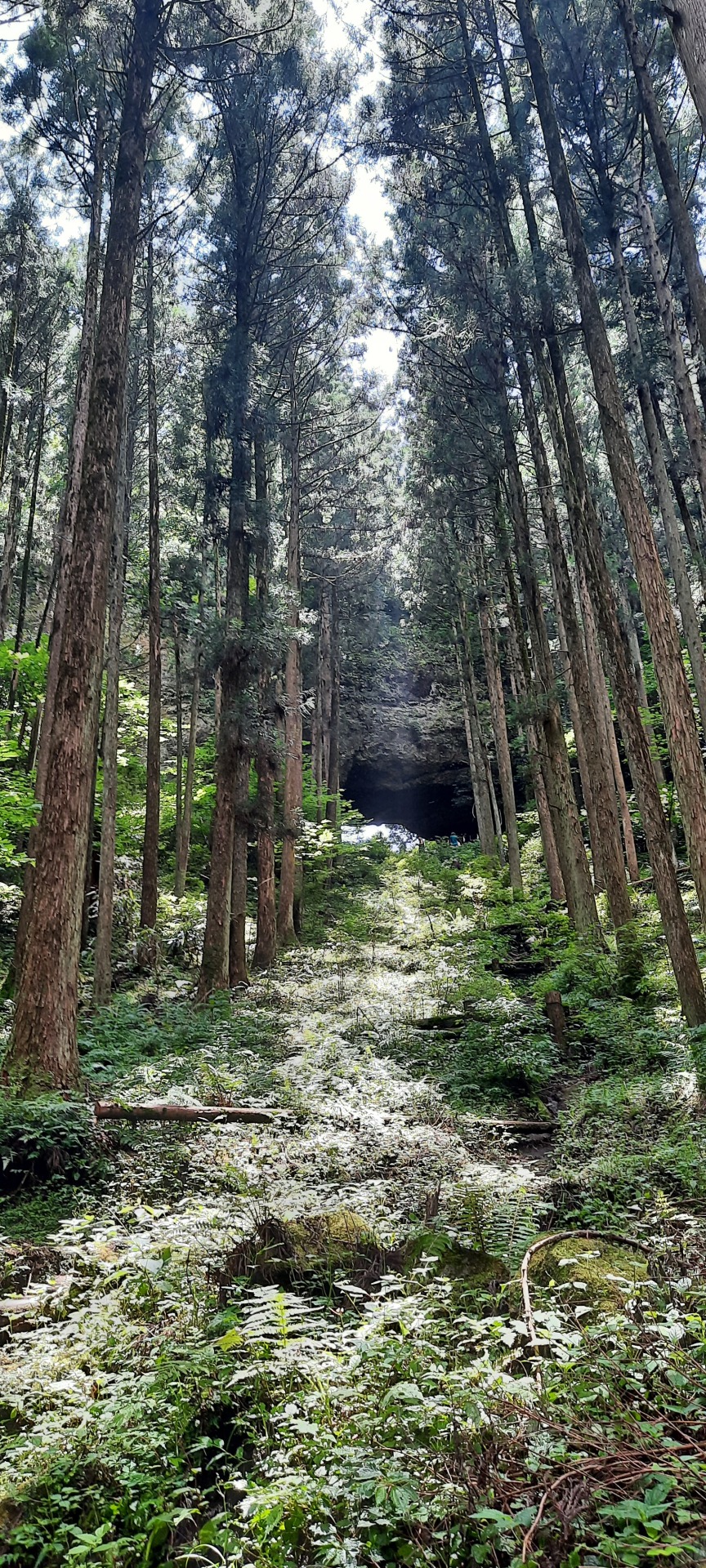


Along the path to the cave as well as around and inside it, are many stone stacks, built by visitors to the shrine and the cave.
While these are most commonly known for helping children stuck at Sai no Kawara (賽の河原) finish their punishment and move on to their next life, they actually have a number of other ritual meanings as well, like symbolically leaving ones impurities behind with them.
Below: The stone stacks.

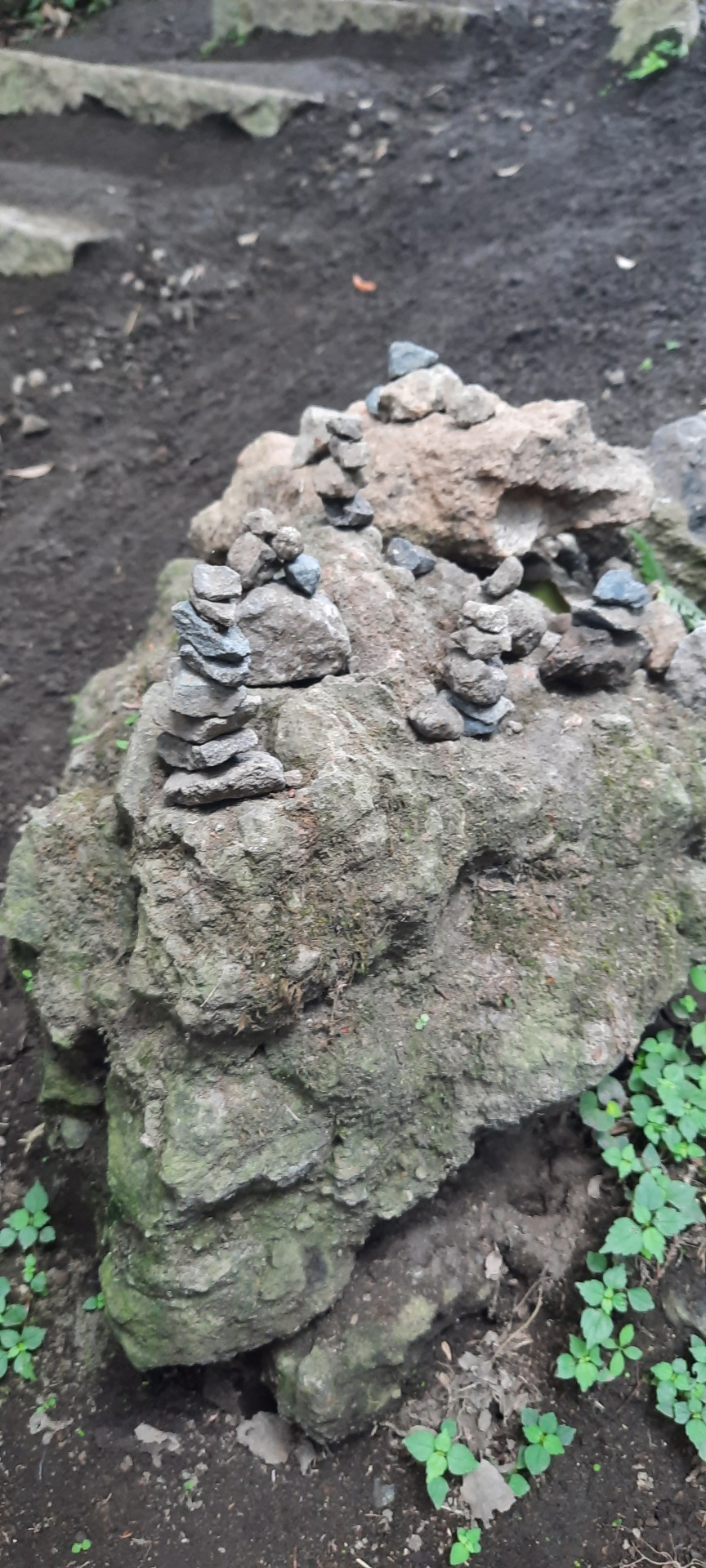

There's no way for me to find out why visitors to this shrine first started stacking stones, but I made my own contribution as well. The top stone you see in the following picture was mine!

I didn't enter the cave myself, since I thought that we weren't allowed to after seeing the shimenawa up top. Though my dad later told me that he saw the locals going in to pray, which led to further research on my part.
This is where I learnt that, the cave itself is sometimes considered a separate shrine of its own, where the mountain in which the cave is found is its shintai. This shrine is known as Ugeto Shrine (穿戸社 lit. "excavated door shrine").
On the left within the cave is its own offering box (which you can kinda see in my picture as well), and in this picture below we can even see sake offered to the god, along with an oonusa again.
Below: The offering box in the cave, from the same travel website previously mentioned.

Thus, with the pinnacle of the shrine reached, we turn around and head back down, moving onto our next destination.
History
Right, with that initial introduction out of the way, we can now get into the history and mythology of the shrine.
First of, its historical origins! Right off the bat, the history of this shrine is not well understood, as its just that old of a shrine.
History as a Ko-shinto Ritual Site
Shinto worship did not always involve these buildings we call shrines, especially in the period prior to the introduction of Buddhism to Japan. This period of the religion is sometimes known as Ko-shintō (古神道 lit. "ancient shinto").
During this period, they had much more simple ritual sites that were often not permanently marked. Thus it's often hard to pin down when a shrine's history truly began, and this is one such case.
It's believed that this site has long been of ritual importance, archaeologists have discovered multiple kofun burial mounds dating back to the 4th to 5th century around the broader Kamishikimi region, in which this modern shrine is found.
And it's believed that the locals at the time often took boulders and blowing caves, a rare type of cave, as objects of worship. Thus it is not a stretch at all to theorise that this cave was one of their sites of worship either.
History as a Shinto Shrine
We have a slightly better idea as to when an actual Shinto shrine was built here, with scholars proposing around the late Kamakura period (1185–1333) or early Muromachi period (1336—1573).
The shrine's records claim that it has its origins in Kishū Kumano (紀州熊野), the southern region of the historical Muro District of the Kii Province, which was also called "Kumano".
Presuming that this is true, this shrine likely has its origins with the famous Three Grand Shrines of Kumano (熊野三山), which would make perfect sense, considering that one of the shrine's names clearly mention Kumano.
As for how shrine of the Kumano faith, originating in the modern day Mie and Wakayama Prefectures, came all the way across the sea to Kyushu, it is believed to tie in with the rise of Shugendō.
During the period, Shugendō practitioners started spreading their faith and shrines across Japan, taking the Kumano faith with them. As they held mountains as objects of worship, it's likely that they decided to set up a shrine on this mountain as well, taking note of its curious cave.
Concrete History
Finally, we have two pieces of (almost certainly) concrete history: First is that the shrine is made to be the overall protector shrine of the local area known as Nangou (南郷 lit. "southern country"), the southern parts of the Aso area.
A second bit that absolutely is true, is that the shrine I visited was not the original building, as it burnt down from the flames of war during the Tenshō era (1573—1592) and was abandoned, only returned to and rebuilt during the Kyōhō 7 (1722).
Mythology
That sorts out history, so lets look at the mythological origins of the shrine, as reported by the shrine itself.
The 2 Gods of the Shrine
The shrine enshrines 2 gods, the famous Izanagi-no-Mikoto (伊邪那岐命) and Izanami-no-Mikoto (伊邪那美命). They are the creator gods that literally gave birth to the many islands of Japan, as well as the many of the gods that inhabit it.
Additionally, the shrine also notes a more local name for the two gods, where they are combined as one under the name "Ugeto-gongen" (穿戸権現 lit. "avatar of the excavated door").
These two are likely the gods of this shrine because they are the chief gods of the Three Grand Shrines of Kumano.
Legend of the Cave, Ugeto-iwa
The shrine also passes down a seemingly legend, seemingly older than the shrine itself, that talks of how the shrine came to be.
Long ago, the god known as Aso-daimyoujin (阿蘇大明神 lit. "Great shining god of Aso"), credited in other legends as the creator and god of the volcanic Mount Aso (阿蘇山), really enjoyed archery.
He would shoot his arrow from the top of Mount Aso and have his retainer, Kihachi-boshi (鬼八法師), retrieve the arrows for him.
One time, finding his task extremely annoying, he picked up one of the arrows in the gap between his toes and threw it at his master out of frustration.
Enraged by Kihashi's actions, Aso-daimyoujin took off in a mad chase after him. Kihashi wanted to escape by climbing over the Somma volcano, but his way was blocked by Mount Tsukigata, the very mountain the shrine is found on.
This is when Kihashi kicked open a hole in the mountain, going through it and continuing his escape from his enraged master. This is how Ugeto-iwa came to be.
Ah, and remember that curious boulder that I came across on the way up to the shrine? That's what remains of the chunk of rock Kihashi kicked out!
The cave and the legend is said to represent "being able to achieve one's goals, no matter the difficulty". This thus lends itself to people saying that it grants blessing of success, victory and passing exams.
As a side note, taking other shrine records and legends into account, Kihashi is involved in many more antics.
He would fart 8 times during his escape, giving a location its name; kick open yet another mountain in his escape, and finally even become a vengeful spirit that causes frost to constantly fall once he was finally caught and executed, amongst many other tales. A surprisingly busy character.
Mythological Origins of the Shrine
While we already went into what the realistic historical origins of the shrine would be, the shrine also gives its own, mythologised account of its origin.
The shrine's records relay a separate a legend where Aso-daimyoujin's ara-mitama, the wild and raging aspect of their soul, is known as Iwagimi-shougun (石君将軍 lit. "General Iwagimi").
Iwagami apparently had a kabuto helmet known as the Hachou no Kabuto (八葉の兜 lit. "eight leaves helmet"), from within which emerged two gods, known collectively as Kumano-daimyoujin (熊野大明神 lit. "Great shining god of Kumano").
Of course, as already mentioned in the history section, the Kumano faith is what would bring Izanagi and Izanami to this shrine in the first place, so it only makes sense that these two are tied back to a locally important god like Aso-daimyoujin.
It is said that when people were about to build a shrine in honor of Kumano-daimyoujin. Two great birds came and took the sasaki branches meant as an offering to the god in their mouths.
The people gave chase, and followed the birds until they reached the eastern foot of this mountain, where they stopped where the cave is. And thus, they took this as a sign and built their shrine here instead, naming it the Kumano Ugeto Shrine (熊野穿戸神社).
Third god of the shrine
A much more minor note, while all sources online list only Izanagi and Izanami as the shrine's gods, a poster I found there adds a third god, Iwagimi-daishougun (石君大将軍 lit. "Greal general Iwagimi").
This is of course not too surprising, as Iwagimi is basically what brought forth Kumano-daimyoujin in the first place. (Which curiously kind of makes him the parent god of the parent gods, funnily enough.)
Ending
And that, concludes my little dive into the Kamishikimi Kumanoimasu Shrine!
If there's one final note to make, is that I totally recommend looking up pictures of the shrine. Its shrine road is especially famous, with many amazing pictures that really give an ethereal vibe.
Oh also, I don't know if any of y'all are into early 2000s shoujo manga (which is extremely specific now that I type it out lol), but Into the Forest of Fireflies' Light, by the same author as the famous Natsume's Book of Friends, was actually set at this shrine! So that's a fun fact~.

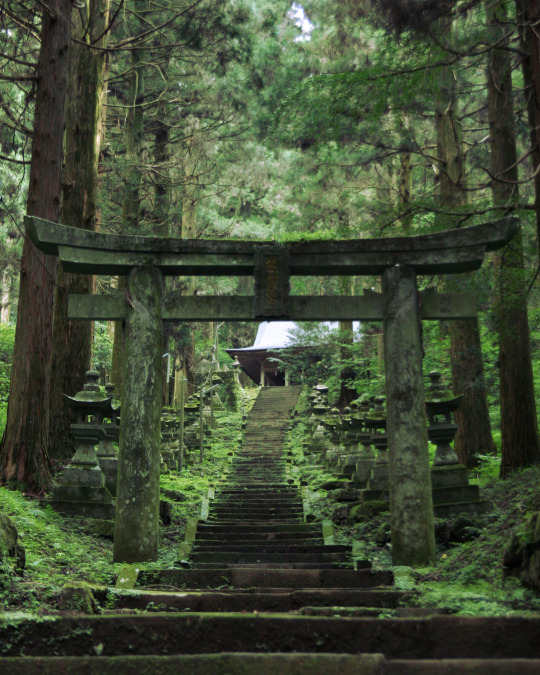
Anywho, that's really all I have now, for real this time. As usual, I hope you enjoyed, even if it's not quite what I usually do~! :)
8 notes
·
View notes
Note
I imagine the Yatagarasu and Kuzunoha clan are very big on self sufficiency, meaning they grow their own food and raise their own livestock. Raidou’s loved animals since he was little, and if an animal needed to stay warm he would happily have them on his lap while worked. I wonder what he thinks about sheep. I think he’d like hanging out with sheep.
love this i love these headcanons anon keep them coming aaaa
i think he’d definitely be a bit of a farm boy. a bit. i don’t see him being the kind to always be able to work on farms due to training and the like but he’d do odd jobs or help with animal care.
the yatagarasu definitely feel like they’d be as traditional as possible, especially considering what we do know about the world the devil summoner series introduces aka demons find it easier to spread their influence and target people (literally the plot of soul hackers is one big allegory for how dangerous technology can be and how it can affect people which tbh old cyberpunk games like that aged too well). since they’re pretty isolated from what we’ve seen, along with other similar groups such as the tsukigata, so yeah they’d probably want less to do with “outsiders” and their pesky influence. tsukigata village is the closest we’ll probably get to figuring out how they operate as a community, also considering how, though the kanto region was rapidly modernizing both in universe and irl, a lot of japan was still heavily traditional (i guess that also might be true now??? there’s a reason as to why games set in modern japan are usually set in tokyo and surrounding cities, as tourism + where a country’s capital is placed has a massive influence on what parts of a country develop the most, so tokyo being both the capital and a massive tourist destination explains a ton).
the capital naturally gets more threats, what with that rapid modernization explained in 1’s opening and science stamping out the belief in the supernatural. you also have a ton of western influence coming in, so actual outsiders twisting what was already set in stone. (i guess this could also be taken as a critique of how the west was and is continuing to damage cultures thus making many customs and traditions obsolete since they’re not western enough.) naturally, the yatagarasu doesn’t stand for that, and especially not the kuzunoha (likely because their lineage possibly dates back to roughly 946—967 CE (according to yokai.com’s page on the legend of kuzunoha which is a very interesting read folklore is cool) so they have a lot to uphold), so they likely reject any and all outside influence. this likely includes raising livestock and other critters naturally found in japan, next to nothing invasive. have to keep it pure.
foxes are actually really popular in japan mainly due to their mythological ties including the actual kuzunoha, so maybe they have a few foxes around too! (immediately imagining all the screaming foxes do they are. actually kinda noisy.)
hey considering how some demons can read the minds of animals and i guess also make it so summoners can understand what an animal is saying, raidou and other summoners probably have a way with them :)
2 notes
·
View notes
Text
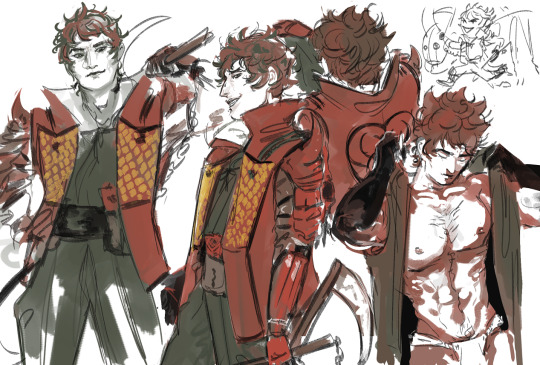




Devil Summoner Raidou Kuzunoha 2 doodles, all older ones safe for the last one.
#Dahn Tsukigata#Raidou Kuzunoha#DSRK#dsrk 2#devil summoner raidou kuzunoha#Geirin Kuzunoha#Nagi dsrk#Akane Tsukigata#own art
304 notes
·
View notes
